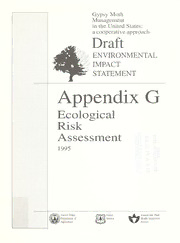
Gypsy moth management in the United States : a cooperative approach : draft environmental impact statement PDF
Preview Gypsy moth management in the United States : a cooperative approach : draft environmental impact statement
Historic, Archive Document Do not assume content reflects current scientific knowledge, policies, or practices. Gypsy Moth Management in the United States: a cooperative approach ^ Draft jJSl environmental STATEMENT G Appendix Ecological Risk Assessment i s r= , 1995 ' J Sc: :: ; ^3 r-v^ United States Forest Animal and Plant ^m|) Department of lUASt ^erv'ce Health Inspection \Qjgry Agriculture Service Assessment Ecological Risk for the Gypsy Moth National Management Program Prepared by: Environmental Analysis and Documentation Biotechnology, Biologies, and Environmental Protection Animal and Plant Health Inspection Service, USDA with the assistance of Dr. Robert Campbell (College of Environmental Science and Forestry, SUNY), Dr. Steven Bartell (SENES Oakridge, Inc.), and Dr. Anthony Gray (Syracuse Research Corp.) Table of Contents List of Tables viii List of Figures x 1. Introduction 1-1 1.1. Background and Purpose 1-1 1.2. Ecological Risk Assessment Process 1-2 2. Exposure and Risk from Gypsy Moth 2-1 2.1. The Forest Environment 2-1 2.2. Gypsy Moth Biology 2-2 2.2.1. Gypsy Moth Types 2-2 2.2.2. Life Cycle 2-3 2.2.3. Host Preferences 2-4 2.2.4. Population Dynamics 2-5 2.2.5. Natural Regulators 2-6 2.2.6. Factors Controlling the Rate of Spread 2-8 2.3. Gypsy Moth Infestation History 2-9 2.3.1. Brief History of Infestations 2-9 2.3.2. Present Distribution 2-9 2.3.3. Potentially Infested Area: Next 15 Years 2-9 2.3.4. Detecting and Evaluating Populations 2-9 2.3.5. Population Size and Distribution 2-10 2.4. Outbreak Duration 2-10 2.4.1. Key Factors 2-10 2.4.2. Density-Dependence 2-11 2.4.3. Population Equilibria 2-11 2.4.4. Aggregating Uncertain Outcomes 2-12 2.5. Ecological Effects of Infestations 2-14 2.5.1. Terrestrial Vegetation 2-14 2.5.2. Terrestrial Animals and Aquatic Biota 2-21 2.5.3. Abiotic Factors 2-36 2.6. Scenarios 2-43 2.7. Exposure Assessment 2-44 2.8. Risk Assessment 2-45 2.8.1. Immune Stands (Less than 30 Percent Defoliation) .... 2-45 2.8.2. Resistant Stands (30 - 60 Percent Defoliation) 2-46 iii 2.8.3. Susceptible Stands (Greater than 60 Percent Defoliation) 2-49 2.8.4. Responses by Selected Habitat Generalists 2-53 2.9. Summary 2-54 2.10. References 2-55 3. Characterization of Active Management Strategies and Treatments 3-1 3.1. Description of Active Gypsy Moth Management Strategies .... 3-1 3.1.1. Suppression 3-2 3.1.2. Eradication 3-2 3.1.3. Slow-The-Spread 3-3 3.2. Description of Active Gypsy Moth Management Treatments 3-4 . . . 3.3. References 3-6 4. Description of Program Areas 4.1. The Two Ecosystem Approach 4-1 4.2. The Development Continuum 4-2 4.3. Physical Characteristics 4-2 4.3.1. Climate 4-3 4.3.2. Soils 4-3 4.3.3. Hydrology 4-4 4.4. Biotic Characteristics 4-5 4.4.1. Flora 4-5 4.4.2. Terrestrial Fauna 4-6 4.4.3. Aquatic Fauna 4-8 4.5. Summary 4-8 4.6. References 4-10 5. Hazard Analysis 5.1. Toxicity Data 5-1 5.1.1. Bacillus thuringiensis var. kurstaki 5-1 5.1.2. Diflubenzuron 5-2 5.1.3. Nucleopolyhedrosis Virus 5-3 5.1.4. Dichlorvos 5-4 5.1.5. Disparlure 5-5 5.2. Terrestrial Field Studies 5-5 5.2.1. Bacillus thuringiensis var. kurstaki 5-5 5.2.2. Diflubenzuron 5-10 5.2.3. Gypsy Moth Nucleopolyhedrosis Vims 5-18 5.2.4. Dichlorvos 5-18 5.2.5. Disparlure 5-19 iv 5.3. Aquatic Field Studies 5-19 5.3.1. Bacillus thuringiensis var. kurstaki 5-19 5.3.2. Diflubenzuron 5-20 5.3.3. NPV, Dichlorvos, and Disparlure 5-21 5.4. References 5-25 6. Endpoint Selection 6-1 6.1. Change in Forest Health 6-1 6.2. Change in Numbers of Nontarget Species Or Their Populations 6-2 6.3. Change in Water Quality 6-2 6.4. Change in Microclimate 6-3 6.5. Change in Soil Fertility, Productivity, Or Stability 6-3 6.6. Summary 6-3 7. The Fate and Transport of Insecticides in the Environment 7-1 7.1. Diflubenzuron 7-1 7.1.1. Fate in the Canopy 7-2 7.1.2. Fate on the Ground 7-3 7.1.3. Fate in the Water 7-5 7.1.4. Metabolites 7-9 7.1.5. Fate of Metabolites in the Canopy and in Soils 7-9 7.1.6. Fate of Metabolites in Water 7-11 7.1.7. Summary - Undeveloped Forest 7-12 7.1.8. Summary - Developed Forest 7-13 7.2. Bacillus thuringiensis kurstaki (Btk) 7-14 7.2.1. B.t.k. on land 7-15 7.2.2. B.t.k. in Water 7-16 7.2.3. Summary - Undeveloped Forest 7-17 7.2.4. Summary - Developed Forest 7-17 7.3. NPV 7-18 7.3.1. Fate and Location 7-18 7.3.2. Transport and Transmission 7-19 7.3.3 Summary - NPV 7-19 7.3.4. Summary - Undeveloped Forest 7-20 7.4. Disparlure 7-20 7.5. Dichlorvos 7-20 7.5.1. Dichlorvos in Air 7-21 7.5.2. Dichlorvos on the Ground 7-21 7.6. Environmental Fate And Transport Modeling 7-21 7.6.1. Methodology 7-22 v 7.6.2. Results and Discussion 7-32 7.7 References 7-34 8. Exposure Assessment 8-1 8.1. Diflubenzuron 8-1 8.1.1. Exposure through ingestion of diflubenzuron 8-1 8.1.2. Exposure through dermal contact of diflubenzuron 8-3 8.1.3. Exposure to diflubenzuron in aquatic environments .... 8-3 8.1.4. Summary 8.2. 4-Chloroaniline (Degradation Product of Diflubenzuron) 8-4 8.3. Bacillus thuringiensis kurstaki 8-4 8.3.1. Exposure through ingestion of B.t.k 8-5 8.3.2. Exposure to B.t.k. in Aquatic Environments 8-5 8.3.3. Summary 8-5 8.4. Disparlure 8-6 8.5. Nucleopolyhedrosis Virus 8-6 8.6. Dichlorvos 8-6 8.7. References 8-8 9. Risk Analysis 9-1 9.1. Diflubenzuron 9-1 9.1.1. Methodology for Nontarget Species Endpoint 9-1 9.1.2. Results 9-4 9.2. Bacillus thuringiensis kurstaki 9-9 9.2.1. Methodology 9-9 9.2.2. Results 9-10 9.3. Disparlure 9-12 . 9.3.1. Nontarget Species 9-12 9.3.2. Forest Health, Water Quality, Microclimate, Soil Productivity and Fertility 9-13 9.4. Nucleopolyhedrosis Virus 9-13 9.4.1. Nontarget Species 9-13 9.4.2. Forest Health, Water Quality, Microclimate, Soil Productivity and Fertility 9-13 9.5. Dichlorvos .9-13 9.5.1. Nontarget Species 9-13 9.5.2. Forest Health, Water Quality, Microclimate, Soil Productivity and Fertility 9-14 9.6 References 9-15 vi
